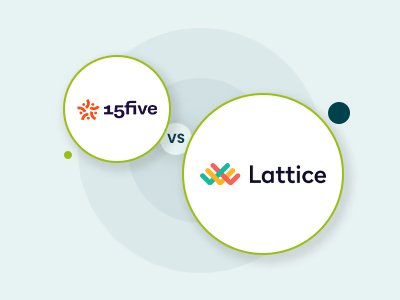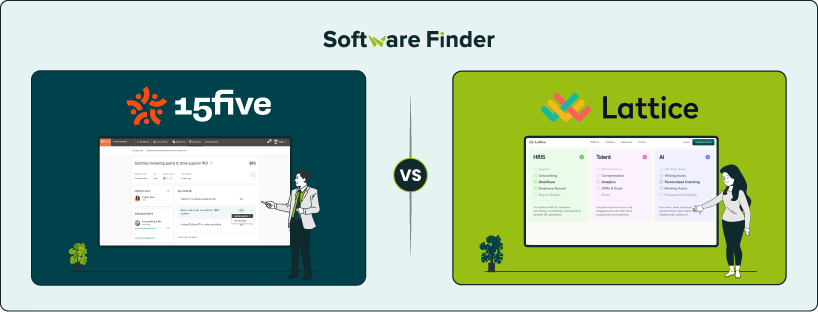
Managing employee performance, engagement, and growth is critical to building a resilient workforce. Whether you’re scaling a startup or optimizing human resources (HR) at an enterprise level, the right people management platform can streamline operations and boost productivity.
That’s where 15Five and Lattice come into play. The two leading platforms offer powerful solutions for performance reviews, goal setting, employee feedback, and employee tracking. While both tools share several core features, their design philosophy, strengths, and use cases differ significantly.
This 15Five vs Lattice comparison breaks down their key capabilities to help you choose the better fit for your team’s strategic HR goals.
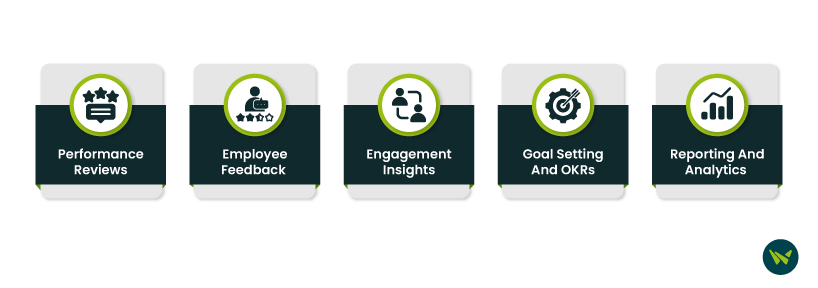
Feature | 15Five | Lattice |
Platform Reviews |
|
|
Employee Feedback |
|
|
Engagement Insights |
|
|
Goal Setting And OKRs |
|
|
Reporting And Analytics |
|
|
15Five is a performance management tool designed to help companies build stronger managers and more engaged teams. It centralized tools for regular check-ins, performance reviews, goal tracking, and engagement surveys. The platform employs a strategic, human-centered approach to strengthen productivity, retention, and alignment across organizations.
A standout feature of 15Five is Objectives, which give real-time visibility into the company and team goals. It helps employees set measurable targets, align their work with broader priorities, and track progress transparently. 15Five also offers extensive integrations with the human resources information system (HRIS), Slack software, Microsoft Teams, and more, enabling seamless workflow connectivity.
Unique Features Of 15Five
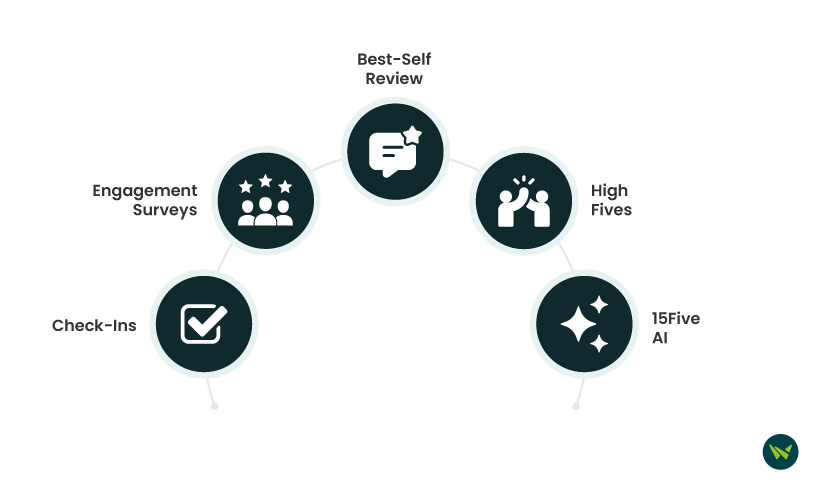
- Check-Ins: Weekly check-ins help the team share wins, roadblocks, and goals in minutes, giving managers instant visibility to offer timely support
- Engagement Surveys: 15Five offers anonymous science-backed surveys using artificial intelligence (AI) to surface trends and risks. Leaders can act fast to improve morale, culture, and retention
- Best-Self Review®: This review tool focuses on strengths and growth, not just past performance, thereby reducing bias and aligning feedback with goals
- High Fives: This feature offers a quick way for peers to recognize each other, building a culture of appreciation and high morale across teams
- 15Five AI: This AI assistant suggests feedback, highlights risks, and offers engagement insights. It saves time and helps managers lead proactively
Pros And Cons Of 15Five
Pros:
- Encourages regular check-ins to help teams stay aligned and surface blockers early
- Boosts team morale through peer-to-peer High Fives and recognition
- Improves transparency and accountability with weekly reflections and feedback loops
Cons:
- User interface may feel overwhelming, especially for new users
- Repetitive questions may lower engagement slightly
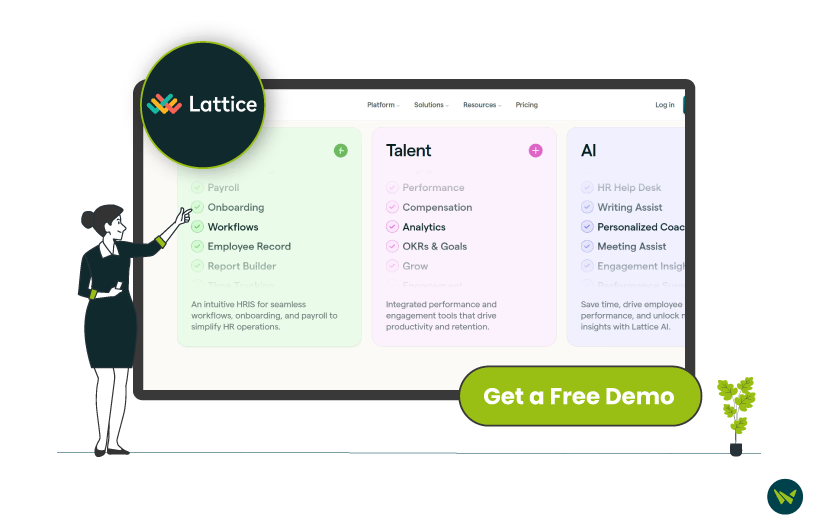
Lattice HR is a cloud-based people management platform that unifies performance reviews, feedback, engagement surveys, objectives, and key results (OKRs) and HR workflows into a single, unified system. It empowers HR teams and managers to align individual goals with company strategy across performance, engagement, and growth modules.
Its standout feature is Grow modules, which enables continuous career development through defined skill tracks, growth plans, and competency frameworks. It supports structured coaching conversations and helps employees build clear paths towards promotion and improvement.
Additionally, Lattice offers seamless integrations with tools like Slack software, Microsoft Teams, Google Workspace software, and major HRIS like ADP and BambooHR. This helps feedback and goal updates to flow naturally within existing workflows.
Unique Features Of Lattice

- Performance Reviews: Lattice helps managers identify top talent and coach every employee. Reviews, feedback, and goals are all in one place for better outcomes
- AI Insights: This assistant summarizes feedback and flags risks. It helps managers have more thoughtful conversations and lead with clarity
- Engagement Tools: The platform offers anonymous feedback tools to surface trends, helping HR leaders bolster morale, retention, and team performance
- Compensation-Based Payroll: Lattice links performance to pay with clear data, enabling managers to make fair, timely, and motivational compensation decisions
- Time Logging: Teams can log, review, and approve timesheets easily. This ensures error-free payroll and smooth time reporting across the organization
Pros And Cons Of Lattice
Pros:
- Supports weekly 1:1s with built-in agendas and action tracking to keep teams connected
- Reveals employee sentiment through pulse surveys, helping managers act on issues before they escalate
- Works smoothly with Slack software, calendars, and other HR tools for efficient workflow integration
Cons:
- Review templates and settings offer limited flexibility without admin access
- Managing question banks and cycles may feel clunky


15Five offers a transparent, tiered pricing model starting at $4/user/month (billed annually) for the Engage plan, which includes surveys, heatmaps, and benchmarking tools. The Perform tier is $10/user/month, adding reviews, OKRs, and 360° feedback. The Total Platform bundle costs $16/user/month, integrating all features plus analytics and manager training modules. Add-ons like manager coaching and compensation tools are available at additional costs.
Lattice follows a modular pricing approach, allowing businesses to select and pay only for what they need. Core modules such as Foundations start at $11/seat/month, while Engagement and Grow are available as $4/seat/month add-ons. Compensation add-on is priced at $6/seat/month. HRIS modules are priced at10/user/month, with Payroll and Time Tracking add-ons available for $6 and $2/seat/month, respectively.
Overall, 15Five offers simpler bundled plans, while Lattice provides scalable pricing for larger, growing teams.
Disclaimer: This pricing is subject to change.
Overall, both 15Five and Lattice deliver powerful performance and engagement tools, but they support different organizational priorities.
15Five is purpose-built for continuous performance management, combining research-based check-ins, goal setting, and engagement tools with predictive analytics. Its intuitive design and structured workflows are ideal for HR teams focused on building a feedback culture and driving employee development.
Lattice, meanwhile, offers a more comprehensive people management platform with deep customization, analytics, and strong integration capabilities. It supports broader HR operations, from performance and engagement to compensation and DEIB, making it a better fit for larger organizations seeking scale and strategic insight.
Ultimately, the right choice depends on your team’s priorities. Evaluate what matters most, whether it is simplicity, development-driven workflows, or enterprise-grade flexibility, and choose the platform that aligns with your goals.
